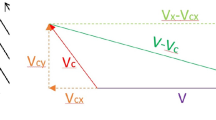Abstract
It is well known that the sufficient family of time-optimal paths for both Dubins' as well as Reeds-Shepp' s car models consist of the concatenation of circular arcs with maximum curvature and straight line segments, all tangentially connected. These time-optimal solutions suffer from some drawbacks. Their discontinuous curvature profile, together with the wear and impairment on the control equipment that the bang-bang solutions induce, calls for ' smoother" and more supple reference paths to follow. Avoiding the bang-bang solutions also raises the robustness with respect to any possible uncertainties. In this paper, our main tool for generating these “nearly time-optimal” , but nevertheless continuous-curvature paths, is to use the Pontryagin Maximum Principle (PMP) and make an appropriate and cunning choice of the Lagrangian function. Despite some rewarding simulation results, this concept turns out to be numerically divergent at some instances. Upon a more careful investigation, it can be concluded that the problem at hand is nearly singular. This is seen by applying the PMP to Dubins car and studying the corresponding two point boundary value problem, which turn out to be singular. Realizing this, one is able to contradict the widespread belief that all the information about the motion of a mobile platform lies in the initial values of the auxiliary variables associated with the PMP.
Similar content being viewed by others
References
L. E. Dubins, On curves of minimal length with a constraint on average curvature, and with prescribed initial and terminal positions and tangents, American J. of Mathematics, Vol.79, No.4, pp.497 - 516,1957.
J. A. Reeds, L. A. Shepp, Optimal paths for a car that goes both forwards and backwards, Pacific J. of Mathematics, Vol.145, No. 2, pp.367–393,1990.
H. J. Sussman, G. Tang, Shortest paths for the Reeds-Shepp car: a worked out example of the use of geometric techniques in nonlinear optimal control, Technical Report SYCON-91-10, Department of Mathematics, Rutgers University, 1991.
J. D. Boissonnat, A. Cerezo, J. Leblond, A note on shortest paths in the plane subject to a constraint on the derivative of the curvature, Research report 2160, National Institute of Research in Infomation and Control, Jan. 1994.
A. Scheuer, Ch. Laugier, Planning sub-optimal and continouous curvature paths for car-like robots, IEEE/RSJ Inl Conf. on Intelligent Robots and Systems, Vol. 1, No. 1, pp. 25 - 31,1998.
D. A. Anisi, Optimal Motion Control of a Ground Vehicle, Royal Institute of Technology (KTH), Stockholm, Sweden, 2003.
J. C. Latombe, Robot Motion Planning, Kluwer Academic Publishers, Boston, 1991.
Author information
Authors and Affiliations
Rights and permissions
About this article
Cite this article
Anisi, D.A., Hamberg, J. & Hu, X. Nearly time-optimal paths for a ground vehicle. J. Control Theory Appl. 1, 2–8 (2003). https://doi.org/10.1007/s11768-003-0002-6
Issue Date:
DOI: https://doi.org/10.1007/s11768-003-0002-6




